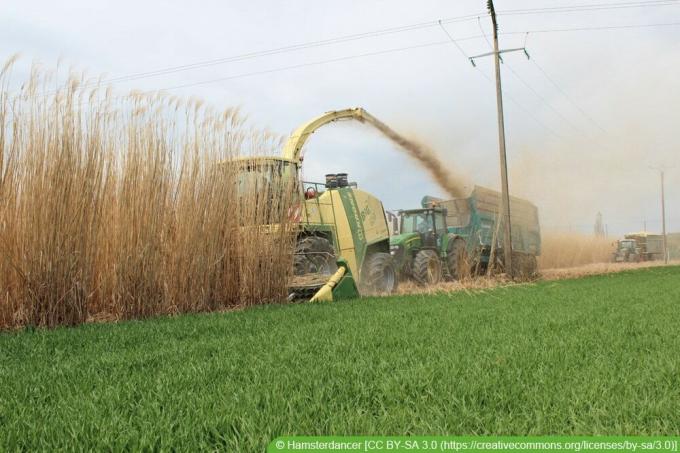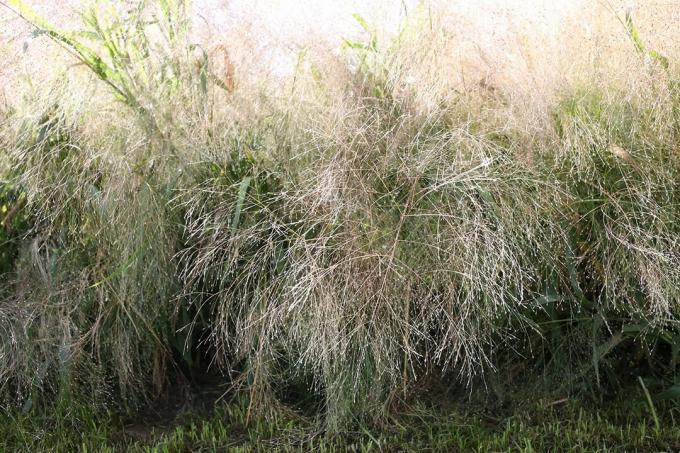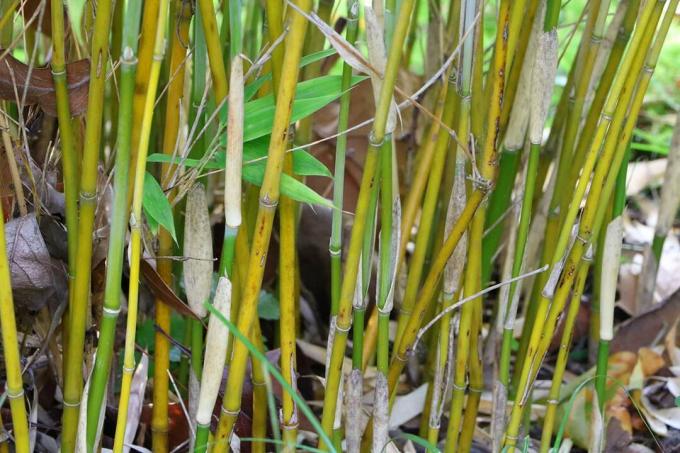

Table of contents
- Characteristics
- sowing
- location and soil
- Plant
- How fast does elephant grass grow?
- heyday
- repot
- watering and fertilizing
- Cut
- hibernate
- multiply
- plant neighbors
- diseases and pests
Miscanthus x giganteus, the giant Chinese reed is a natural hybrid of two Miscanthus species, namely the silver Chinese reed (bot. Miscanthus sinensis) and silver flag grass (bot. Miscanthus sacchariflorus). It was introduced from Japan back in the 1930's and still enjoys great popularity. With a height of up to four meters, it is an attractive yet easy-care eye-catcher in any garden.
Characteristics
- botanical name: Miscanthus x giganteus
- Origin: Asia
- Growth height: 3 to 4 m
- preferred location: sunny to semi-shady
- Preferred soil: fresh to moderately moist, sandy to loamy, rich in humus
- Flowers: red flowers in panicles
- Flowering time: October
- Leaves: grassy, long and narrow, different colors depending on the variety
- Special features: hardy, lime-tolerant, picturesque growth, fast-growing, clump-forming
sowing
should that Miscanthus x giganteus are blooming in your garden, then unfortunately you cannot hope for germinable seeds from them, as they are sterile. However, you can propagate the reed by dividing a plant or its rhizomes.
location and soil
Miscanthus x giganteus prefers a location that is as sunny as possible, but also thrives in semi-shade. The more sun the grass gets, the more vital and strong its leaves and stalks become. In addition, flowering is unlikely in partial shade. The giant reed has no special requirements for the soil. It tolerates lime and is relatively robust, but prefers fresh to moist, not wet soil. This may be nutrient-rich and humic. However, it is more important for the young reed that the surrounding area is free of weeds, because its roots cannot yet assert themselves well against it.
Plant

When planting, remember that elephant grass can grow very large and reach an enormous extent. Therefore, plan for a corresponding space requirement. There should be a distance of at least one meter to the neighboring plants, better even one and a half meters. A good month for planting is May.
It is best to plant your giant reed in slightly moist, well-drained soil. If the soil in your garden is very compacted, loosen it thoroughly. If the soil is dry, you can also enrich it with some ripe compost. A drainage layer may also be recommended, because the grass does not tolerate waterlogging. After planting, water your giant reed well. A rhizome barrier is only necessary if the ornamental grass borders on a high-maintenance green area.
Tip:
You can also cultivate elephant grass in a bucket, where neither rhizome formation nor weed competition is a problem. However, it is essential that you use a sufficiently large planter (capacity at least 50 litres).
How fast does elephant grass grow?
Miscanthus x giganteus is one of the fast-growing plants. It can reach the impressive height of three to four meters. The daily increase is up to 5 centimeters. Despite its imposing size, it appears light and airy. However, the growth depends on the location and the daily solar radiation.
Many gardeners and/or garden owners see the very slow growth of the rhizomes as positive. The rhizomes (root shoots) of elephant grass grow much less than those of other Miscanthus species. A rhizome barrier is therefore not necessary in many cases.
heyday
If you live in a mild region or if the summer was consistently warm and sunny, then you can maybe from September or October on the filigree flower panicles of your elephant grass be happy. However, the grass takes about two years before it flowers for the first time. The flowers are initially pink, later turning silvery white. In cool regions or after a summer with little sun, the giant Chinese reed usually does not form any flowers at all.
repot
If you have planted your ornamental grass in a bucket or other container, then you should repot it regularly every two or three years. It is necessary at the latest when the planter is visibly too small. The ideal time for repotting is spring, before the grass sprout and working with the meter-high plant becomes too tedious.
watering and fertilizing
Freshly planted giant Chinese reed should be watered regularly for the first three months, ideally even daily. Once it has grown well, it only needs additional water when it is dry. You should only fertilize the reeds if they are in very poor, nutrient-poor soil. Young plants do not tolerate fertilizer at all. Caring for a container plant is very different from caring for an outdoor plant. However, you should keep an eye on the water supply.
Cut
Once a year you should cut your giant reed down to the ground (about ten centimeters high), then it will sprout again nicely in the spring. You can do this pruning in autumn or winter, or in spring just before new growth. It is up to you when you decide, both variants have advantages and disadvantages.
Pruning in autumn or early winter is recommended if you live in a region with particularly cold and harsh or particularly wet winters. In this way you can better protect the rootstock from frost and cold, but above all from moisture. To do this, cover the eyrie with straw, brushwood and/or leaves. In the spring, however, remember to uncover it in good time, otherwise your reeds may shrink under the protective layer.
Tip:
If you cut your ornamental grass in spring, you get a great eye-catcher in the winter garden, because the frosted panicles look beautiful. In addition, the stalks protect the rootstock from the cold to a certain extent. At the same time, the grass serves as winter quarters for many insects.
hibernate
The giant Chinese reed is considered frost hardy down to about - 20 °C as soon as it is about two to three years old. Younger plants are often damaged at temperatures of around + 5 °C. Therefore, you should definitely protect young elephant grass from frost. It is best to overwinter a container plant in a frost-free building, in the garden frost protection is essential. If you leave your giant Chinese reed in the garden over the winter, you can tie the stalks together so that the reed is better protected from wind and snow.
multiply
The giant Chinese reed can easily be propagated by dividing the plant or removing rhizomes. The best time to do this is in spring (March or April) when the elephant grass is just beginning to sprout. Dig up the grass and divide the root clump into two or more parts with a sharp spade. Then plant them back in separately.

Alternatively, you can separate individual rhizome sections. These should be at least seven to ten centimeters long and have four to five eyes. The larger such a rhizome section is, the better it can grow and sprout. For this, however, the tissue must be firm and healthy.
Tip:
When you have dug up the elephant grass, check the roots immediately for soft, rotten or blackened spots. Remove these generously. This keeps your giant Chinese reed healthy and robust for a long time.
plant neighbors
The giant Chinese reed is excellent as a solitaire, but can also be used as a structure plant. The giant reed is also gladly underplanted with small grasses (e.g. moor grass), with sedum hens, water hazel or asters. This is a good way to conceal the lower leaves, which turn brown and die in late autumn. Sunflowers, phlox or torch lilies also go well with this ornamental grass.
diseases and pests
Neither diseases nor pests are a cause for major concern with Chinese reed. Only fungal diseases occasionally occur as a result of excessive moisture or incorrect care. As a rule, the location is not well chosen. The grass may also have been watered too much or the soil is not permeable enough.
 garden editorial
garden editorial I write about everything that interests me in my garden.
Learn more about ornamental grasses

cutting bamboo | When and how to cut back bamboo?
Be it as a hedge, solitaire or ground cover, bamboo can be seen more and more often in home gardens. Because the sweet grass is easy to care for and easy to grow. However, the latter can quickly become a problem if the plants are not pruned regularly.

11 Tips for Cutting Grasses | Tools & Co.
Cutting ornamental grass works best with our tips: From choosing the right tool to right time - we have the most useful tips and tricks for you for the annual grass cut summarized.

Switchgrass, Panicum virgatum: Care from A – Z
Switchgrass is an upright-growing, clump-forming grass with narrow leaves. The species is considered to be easy to care for and makes few demands on location and soil. Read how to optimally plant and care for Panicum virgatum.

Zebra grass, Miscanthus sinensis 'Strictus': care from A - Z
In botanical jargon, zebra grass is also called Miscanthus sinensis 'Strictus'. The plants can be used wonderfully as privacy screens and are decorative. From care in the tub to overwintering: You can find information on care from A - Z here.

Grow pampas grass from seeds: we explain how
Pampas grass is considered easy to cultivate and can be successfully propagated by breeding. Under controlled conditions in the planter, the germination success is higher than with direct outdoor sowing. The procedures regarding substrate, choice of location and care hardly differ in these variants.

Grasses as a privacy screen: 20 tall grasses
Numerous grasses are ideal as privacy screens! We present the 20 most popular grasses in this article!



